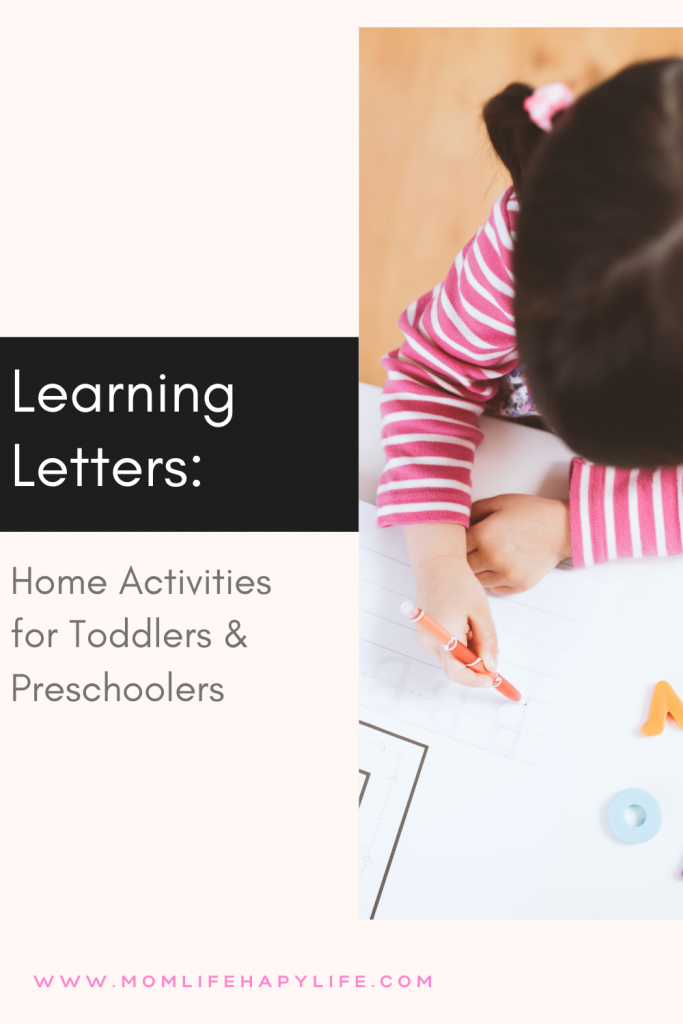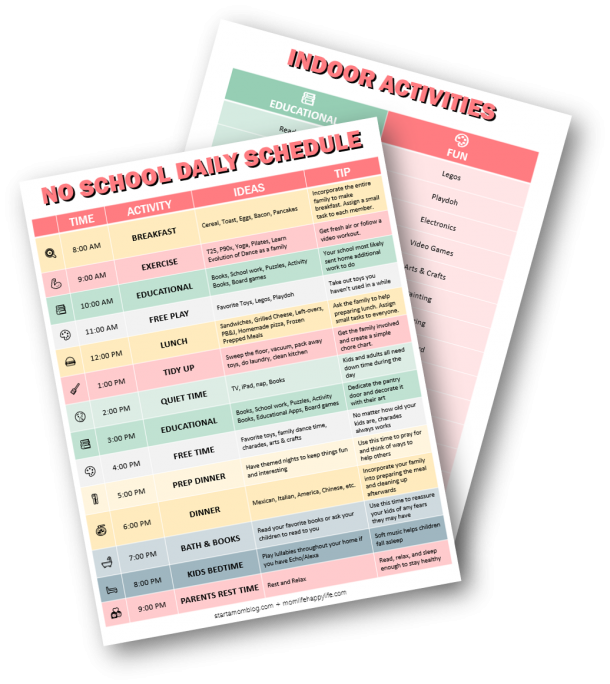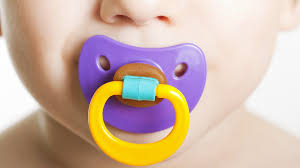One of the most common questions I get as a developmental and behavioral pediatrician is, “When should my child be learning letters?”
As a mom, I can understand the pressure. We see so many activities on Pinterest about teaching the letters of the alphabet at age two, or even younger. On our Instagram feed or Facebook mom groups, we see toddlers who seem to have memorized the alphabet.
If you are worried about whether your toddler should already learn their letters, read on. You’ll know the right time to start introducing the alphabet to your toddler. You’ll also know what to do at different ages.
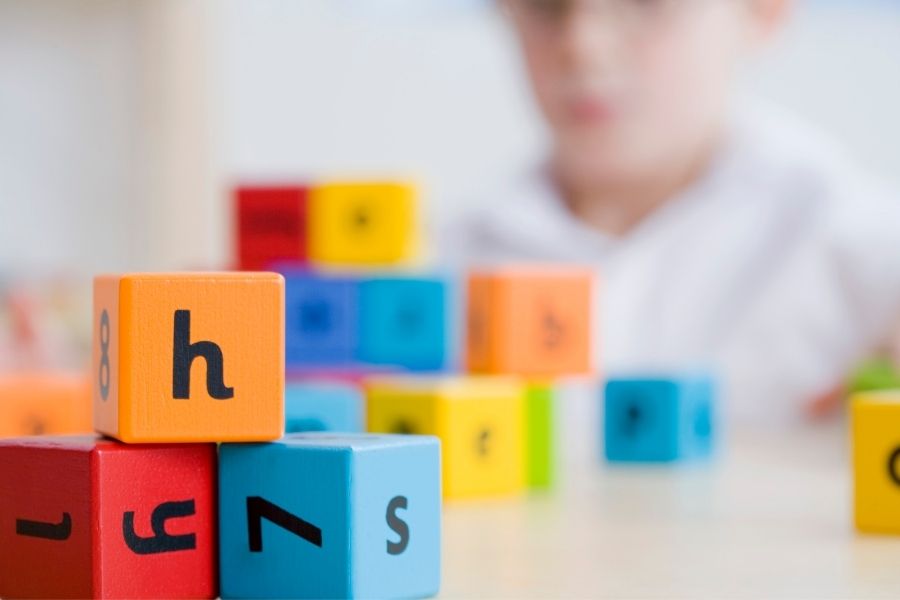
When should kids learn the letters of the alphabet?
In our clinics, we expect that kids should learn the letters of the alphabet at around four to five years old. Yes, you read that right. FIVE years old.
Not two, or even three years old. Here are the expected developmental milestones for learning letters according to the American Academy of Pediatrics:
A four-year-old can identify many (read: many, NOT all!) numbers and letters. A five-year-old can recite the alphabet and count out loud. By the end of kindergarten, they know the sounds for most of the vowels and consonants.
Learning letters is not a one-time, all or none skill. It is not merely learning how to sing the alphabet song. Singing the alphabet song is no different from singing, say, “Twinkle Twinkle Little Star”, and this is not a sign that you should hurry and make your child learn letters.
Many things need to happen for your child to really know the alphabet. These are:
- A good grasp of verbal language
- The knowledge that words and language are made up of sounds
- Remembering the form that letters take. This can be confusing – because, especially in the English language, each letter can take on different forms!
- Understanding how each letter corresponds with a sound. This is confusing too. Many sounds can go with the same letter, and the same letter can be sounded out in many ways.
Here are some things that we do when we assess a child’s development. At around the age of four, we show some blocks that look like scrabble tiles and ask the child to name the letters. We don’t even expect them to get all of them at that age!
At around the age of five, we ask them to read single letters of the alphabet that are printed on paper. We also try to see whether or not they can copy them. Again, we don’t expect them to do it perfectly! We don’t ask a child to read CVC words until first grade.
This is a far cry from what we see all over the internet. So if you have a toddler, remove learning letters from your list of worries. As you’ll see in this article, there are many things you can do that will naturally build this skill, setting the foundation for when your child is ready.
Fun and easy ways to help your child learn letters at home
Here are ways to help your child learn letters at home, at each age of development.
Many of them are different from the usual activities you get when you do a Google or Pinterest search for “toddler activities to learn letters”. But these are very important and effective learning activities! These also don’t require any preparation.
You may even already be doing many of these. If you are, know that you are doing great! There’s no need to keep searching for more, always feeling as if you’re not doing enough.
Any age
Just talk with your child.
It’s amazing how this activity is so simple, and yet you never find it in any list of “toddler activities”. That’s because it seems so obvious.
However – and I know this from experience – we can get so busy lining up activities that we forget to just talk with our kids.
And yet, research shows that this is the single best thing that we can do to help our kids learn. It’s also easy, no-prep, and doesn’t cost a thing.
Now, you may wonder, how can an activity like talking with your child help with learning letters? The answer is – plenty!
That’s because before your child can learn letters, they first need to understand that these letters mean something and correspond to sounds. That means that interactive communication is the foundation of learning the alphabet.
You can’t simply jump to teaching letter-a-day or letter-a-week activities, without first building a foundation of good verbal language skills.
That’s also why many “toddler activities” from the internet only entertain your child for a few minutes. It’s because the basic skills and also the brain pathways needed to enjoy and appreciate the activity just aren’t there yet.

Read with your child.
This is the best way to set the stage for your child to learn and enjoy reading. You can start at any age – even while your child is still a baby.
Reading with your child is NOT the same as teaching your child to read. The purpose here is simply to enjoy the experience and to connect with your child.
1 ½ – 2 years old
At this age, your child is naturally exploring. This is how they learn and get the developmental stimulation they need. Your child’s desire to explore is nature’s way of making sure they learn!
Name items as your child explores them.
As your child points to or moves towards something they are interested in, name it. Comment on it. This is one of the best things you can do to help your child’s development at this age.
Recite and sing nursery rhymes with your child.
Nursery rhymes are an enjoyable and excellent way to set the stage for your child to learn letters as they grow older. Through nursery rhymes, your child learns about how sounds combine to form words.
Let your child play with alphabet blocks or foam letters.
During the preschool years, you can use objects that give your child a tactile feel for these letters. Examples of these are embossed alphabet blocks, foam letters, or books with cut-out shapes of the letters.
However, don’t expect your child to know these letters. Also, don’t go overboard preparing these!
Use board books that weave in letters of the alphabet into a story.
There are many good books that use letters of the alphabet in the story. Here two books that I used:
- Dr. Seuss’s ABC Book
- Mrs. Peaknuckle’s Vegetable Alphabet. (Another thing I love is that this encouraged my toddler to try more vegetables. 🙂 )
Don’t stress about having your child memorize the alphabet from these books. Simply enjoy reading the book with your child, just as you would with any other book.
I prefer books that actually have a story, rather than books that just show a picture and a word. The latter are actually flashcards more than they are books.
2-3 years old
Continue the same activities mentioned above. Your child will be able to appreciate and enjoy these even more.
At this age, books will occupy them longer. Giving a stack of books may even give you the 15-20 minutes of quiet time that you need to get a thing or two done.
Then, add the following activities to your repertoire. Do them in a fun way. If you notice you or your child no longer enjoying it at any point, stop!
Point out the letters when you read with your child.
When you read to your child, you can start pointing out the letters of the words. Start with the letters in the title. Continue asking questions and having conversations about the book too.
Show your child too that the letters represent sounds. Emphasize the sounds in each word. Don’t be afraid of sounding silly!
When naming something, tell your child what letter that object starts with.
You can do this throughout the day as part of your conversations. Do this when it feels natural. Again, there is no need to go overboard! As always, what is most important here is the connection between you and your child.
Use a set of flashcards.
Yes, I think it’s best to wait until at least the age of two before introducing flash cards. If you want to wait until your child is three or older – or even if you never use a set of flashcards – that’s fine too!
3-4 years old
By this age, your child is technically no longer a toddler, and enters preschool age.
Continue reading with your child. Continue having conversations with your child throughout your daily routine. If you do only these two things, you’ll be well on your way to teaching what your child needs to learn!
If you want to, you can add these activities as well:
Show your child how you write letters of the alphabet.
Use crayons, chalk, a pencil, paint brush, or any safe material that you like. You can even use your fingers on play doh or on sand. Demonstrate writing the letters of the alphabet.
Just have fun with this. Your child will soon imitate you.
However, do not expect your child to be able to form these letters at such an early age. We expect a child to be able to copy a circle at age 3, a cross and a square at age 4, and a triangle at age 5.
Think of, say, the letter A, which needs the same fine motor skills as drawing a triangle. So don’t expect your three-year-old to be able to do this.
Write your child’s name and point out the letters.
Point out the letters in your child’s name. Say them out loud.
Tell stories about the letters of the alphabet as you see them.
As you go about your daily routine, you’ll come across the letters of the alphabet. You’ll see them in books, cereal boxes, or signs at the places you go.
When you see these, point out the words to your child. Point out the first letter in a word too. Add a “story”.
Here are examples of some stories that I used and that my child enjoyed.
- The letter “C” looks like a crescent moon. (My child came up with this himself. We’d gone outside at night and I showed him the “crescent moon.” Afterwards, when he saw the letter C, he said, “crescent moon!”.)
- The letter “I” looks like me when I am standing up straight.
- The letter O looks like my mouth when it says “O”. See here? Take a look at my mouth. “O”! (My child had a good laugh with this, and he enjoys saying an exaggerated “O” 🙂 ).
Form letters of the alphabet using craft sticks, cotton buds, or colored tape.
My child who came up with this one too. 🙂 He’d helped himself to a pack of cotton buds. He formed three of them into an “H”, and asked, “Mommy, what letter is this?” I told them it is the letter H, and showed how by closing the two ends at the top, I’ll form the letter A.
Trace letters in the air using your hands and arms.
Using movement is a great way to help your child learn the letters of the alphabet. Again, just have fun with this. Don’t force your child to memorize or make “perfect” movements.
Five Things to Avoid During the Toddler Years
Complicated activities
Avoid complicated activities, such as matching letters with the objects they represent. Or matching uppercase and lowercase letters. These are too advanced for toddlers.
Also, as toddler moms, we don’t have a lot of time on our hands. Avoid anything that you need to spend time preparing. Your child will learn the alphabet, whether or not you stay up late at night combing the house for ten things that start with the letter D.
If you want a more in-depth guide on how to choose age appropriate activities, this is one of the topics I cover in my online course Learning Through Play 101: Unlock Your Child’s Inner Genius Through Play.
Worksheets and workbooks
Don’t expect your toddler to be able to trace letters of the alphabet or cut them out, match drawings to letters or words, color within lines, or complete written exercises. If you already have a bunch of worksheets lying around, either keep them for when your child is older, or just use them as pages for free scribbling.
Also, avoid programs that promise to have your child reading by age three or even four. These put too much pressure on you and on your child. There is plenty of time for your child to learn later on.
Research shows that the only advantage of learning to read early is better grades when your child first starts school. That’s it. In fact, in the long term, those who learned to read too early even did worse as adults!
Overwhelming environment
Resist the urge to fill every square inch of your child’s playroom with alphabet posters, stickers, mats, and a hundred other things. A simple environment works better to encourage your child’s learning and creativity.
Apps and games
At this age, tech-free is best. Around the time your child turns two, you may introduce videos. Examples of good videos are those with actual people singing the alphabet song or reading a book aloud. Avoid videos with fast animations.
Also, I don’t recommend using apps and games to learn letters. For example, don’t use an app that instantly rewards your child with stars or animation when they tap a letter correctly. This is too stimulating to the reward center of your child’s brain, making offline learning more difficult later on.
Activities that use choking hazards or other unsafe items
This is a big problem that I see with many activities on the internet. They use items such as beads, buttons, letters with tiny magnets, or dry pasta shells. These are choking hazards for toddlers. Why take the risk, when you have so many safer ways to have lots of fun while learning.
When Should I Worry If My Child is Not Learning Letters?
This is another common concern of the parents whose kids I see in my clinic. They want to know whether they should worry that their child hasn’t learned letters yet.
During the preschool years, as pediatricians, we don’t worry if a child hasn’t learned their letters. What we really watch out for are signs of speech and language delay.
That’s why interactive language and conversation skills are our priority during the toddler years. Not learning the alphabet. In fact, when a child memorizes the alphabet very early, it can mask signs of speech delay.
For example, I have seen kids who can recite letters of the alphabet at age two or even earlier. However, they can’t answer questions such as, “What’s your name?” or follow commands like “Point to mommy/Where’s mommy?”
Over and above learning letters (or even numbers, colors, shapes – any of the things many moms worry about) – it is very important that your child learns interactive conversation.
When a child enters first grade though, we do want to see that a child enjoys reading and is reading for pleasure. This is the age that we get concerned about reading difficulty.
If at any age, you have any concerns about your child’s development, you should speak with your doctor or pediatrician about it.
Final Thoughts on Activities for Learning Letters
I’m sure you and your child will come up with many more of your own learning activities! Stop worrying about having complicated activities to teach the alphabet to your toddler.
Learning letters is NOT the priority. That’s why the activities in this guide focus not on memorizing letters, but on building meaningful language skills.
In the end, your child learns these skills best through your loving relationship. Through those everyday moments of connection with you. You’ve got this, mama. You ARE enough, and you’re doing great!
If you found this article helpful, you’ll love my free guide to fun, easy, no-prep toddler learning activities and my online course Learning Through Play 101: Unlock your Child’s Inner Genius Through Play.
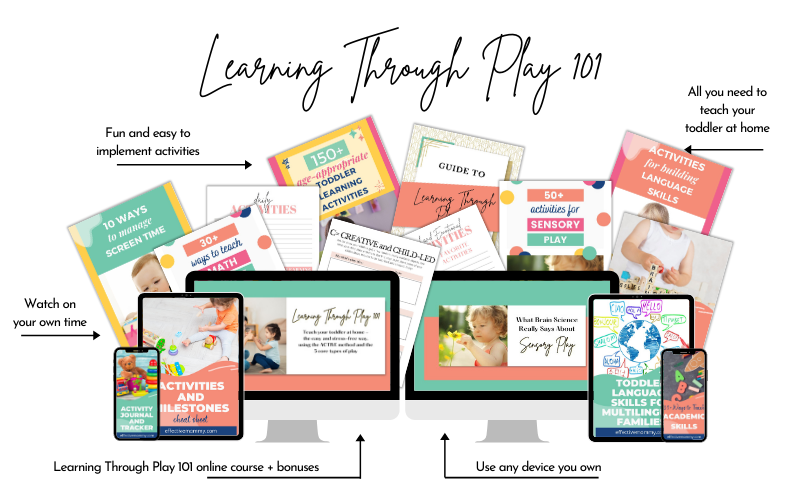
About the author: Dr. Victoria Nolasco is a developmental and behavioral pediatrician, clinical associate professor of pediatrics, and a certified positive discipline coach. She is also mom to an almost-three-year-old. Her blog, effectivemommy.com, is dedicated to happy and confident parenting for toddler moms.
Disclaimer: This article is for informational purposes only and DOES NOT CONSTITUTE THE PROVIDING OF MEDICAL ADVICE. It is not intended to be a substitute for independent professional medical judgment, advice, diagnosis, or treatment. You should never disregard or delay seeking medical advice because of this information.
The information in this article or on the linked websites should not be considered current, complete or exhaustive, nor should you rely on such information to recommend a course of treatment for you or any other individual. Reliance on any information provided on this website or any linked websites is solely at your own risk. We have no liability in any way to you or any other entity for any injury, loss or damage, direct or indirect, arising from the use of information contained herein.
